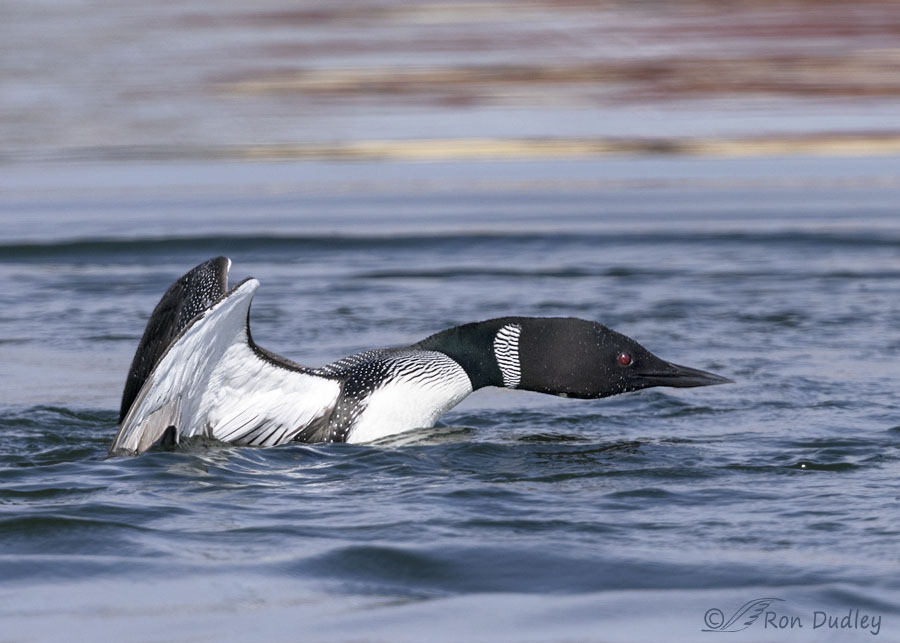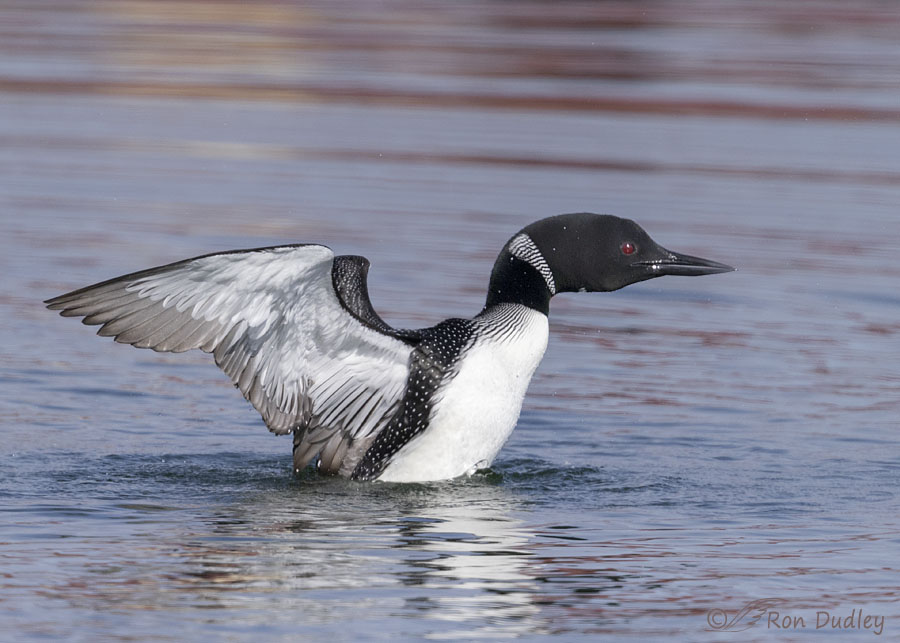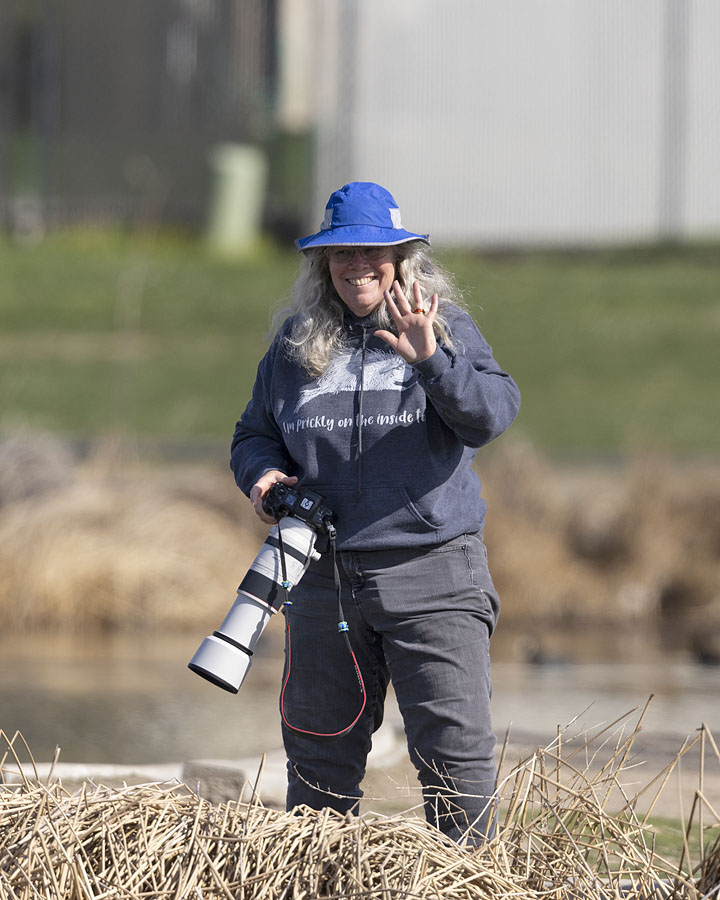Some readers who are “in the know” may have wondered why I haven’t posted any Common Loon photos recently. After all, loons are migrating now, there’s been an unusually large number of them on valley ponds and one of those ponds is one that I visit frequently. The answer is complicated but it primarily revolves around the fact that getting good light on the loons requires walking around the pond while carrying my heavy gear (including tripod) and my bad back just can’t tolerate it.
However, I did try one time – nine days ago. I couldn’t walk far enough to get the best light but I did get a couple of partially side-lit photos that I think are interesting enough to share.
It all began with a loon fight. I never got quality photos of both of the birds fighting, only of the fight’s aftermath.

1/8000, f/6.3, ISO 640, Canon R5, Canon EF500mm f/4L IS II USM + 1.4 tc, not baited, set up or called in
While they were fishing the two loons typically stayed far away from each other but occasionally one of them would submerge, swim a long distance underwater and ambush the other loon in a surprise attack from below. Cornell’s Birds of the World describes it this way:
“Underwater attacks can occur when one bird swims directly under another and tries to impale the victim on ventral side with its bill. Sometimes during these fights, one bird will hold the other bird’s head underwater, possibly for a period of a minute or more, before the weaker bird escapes. Necropsies reveal that > 50% of individuals examined (n = 200) have healed sternal punctures consistent with injuries inflicted by a loon bill.”
As suggested by Cornell, sometimes one of the combatants will be injured or killed but thankfully that didn’t happen this time. This photo was taken of the victor in a threat display as the loser of the fight was escaping stage right. The ripples and waves in the water that were caused by the furious fighting are still evident in the photo.

1/6400, f/6.3, ISO 640, Canon R5, Canon EF500mm f/4L IS II USM + 1.4 tc, not baited, set up or called in
Then the same loon performed a victory wing flap.
Proper exposure of these black and white birds in the side light was a challenge but with a little work on the blacks during processing these two photos didn’t turn out too bad.
OK, now I’ve posted a couple of loon action shots. Maybe that’ll scratch my loony itch.
Ron
PS – If you’re interested here’s a link to a video of a loon swimming and fishing underwater.
Late Addendum: Meet blog follower, bird rehabber extraordinaire and my good friend April Olson. April was photographing loons that morning too. She was across the pond (in better light for the loons than I had) so I waved to her, hoping to get a wave back. She responded with both a wave and a nice smile. Despite what it says on her sweatshirt, April isn’t prickly on the inside or the outside.
By the way, April and I use the same camera, the Canon R5. But her lens is much smaller and lighter than mine (even though they’re both 500mm – hers is a zoom) so it’s easier for her to carry her gear than it is for me to carry mine. And she doesn’t have to carry a tripod.
Thanks for all you do for birds and critters, April.



Ron,
Loons! Who would have thought? I need to go and try to find some.
And if you ever need a sherpa …
Stephen
Ha, thanks for the offer, Stephen. You may regret it… 🙂
Didn’t realize that loons were so vicious! Yikes! Ron, we need to find you a camera caddie (like a golf caddie) to lug your equipment around for you.
April, it’s nice to see you again! I believe that the last picture of you that Ron posted on his blog was during a bird release because I recall seeing a carrier. (Of course, I could be totally wrong, as I often am 😹)
Here’s to aging like a porcupine! 😉
“we need to find you a camera caddie (like a golf caddie)”
You mean like a golf cart? I’ve actually got one, Marty – see second photo in link below. I’ve been thinking about digging it out of storage and trying it at the pond. I’d still have to walk that far but maybe I could do it, on a good day.
https://www.featheredphotography.com/blog/2010/08/19/how-i-photograph-birds-3/
Yes, some years ago I posted a photo of April doing a Burrowing Owl release, from a carrier. You have a good memory.
I was thinking of a human caddie (could carry your donut and milk too!), but something on wheels would work too.
I forgot to ask if you’re anywhere near where those two houses slid down the hill yesterday.
Nope, those two houses are (were) in Draper, maybe 20 miles south of me. I suspect they were built on one of the old Lake Bonneville benches, as many of them in that area were. Houses should never have been allowed to be built up there, but money talks.
Lol. Thank you for the nice words. I don’t like using a tripod, I find it too hard to track birds in flight. For now I can hike, carry and handhold my gear. It is much lighter than the 7DMII with 100-400 and 1.4TC, that I used to pack around.
As I age afraid I am getting more prickly on both sides.
April, if you’re prickly you’re an amateur compared to my roses.
I was pruning them this morning and one of the thorns got me. It must have punctured an arteriole in my finger because the blood was bright red and almost gushing – to the point that it took a tight bandage to stop the bleeding. Right now I can barely type because of the bandage.
Had I not read your description of this bird’s activities I could imagine in the first photo that he’s taking a sunset swim in a lake using the butterfly stroke … so the fact that he was undertaking an underwater attack against a fellow loon certainly shatters that illusion. The swimming videos prove loons don’t use the butterfly! 😉
Nice to see April out there, too — my guess is even her “lighter weight” gear would be more than I could handle!
Chris, April’s lens is a new one that only weights 3 lbs. so I imagine you could handle it. My lens weighs over 7 Lbs. and that’s pretty light for the kind of lens it is. The older version of the same lens (that I used to own) weighs even more. Another concern with my lens is bulk – it’s a very large lens. But I love it.
Pecking order is NOT an empty phrase.
And yes, that bill very obviously has immense potential as a weapon. The submarine attack was new to me but doesn’t surprise me.
Nice to see April too.
“Pecking order is NOT an empty phrase”
Perfect, EC.
It’s always nice to see April, unless her unexpected appearance at a birding site means her professional skills are needed. But even then I’d be glad to see her.
I think a lot of folks, including me, like to assume that nature, at least birds (raptors perhaps excepted), are benign and relatively nonviolent even though we may see them squabble and chase each other. You often document, both photographically and journalistically, the reality of the struggle for survival. You strike a good balance in sharing the beauty and the beast, the yin and yang inherent in life.
Granny Pat’s comment is thought-provoking.
It’s nice to “meet” April. Her good reputation precedes the photo by her insightful comments and your many admiring references about her and her work for birds.
And those red eyes will forthwith have an added sinister aspect to them in addition to their stunning beauty.
“the beauty and the beast, the yin and yang inherent in life.”
Once again I like your phrasing, Lyle.
And yes, April is one of the good guys. The amount of time and effort she donates to her patients is impressive. And she’s very knowledgeable regarding what should and shouldn’t be done for them.
Like Deb, I’m gonna “have to work on the real life of a loon.” My loon experience is Katharine Hepburn rhapsodizing to Henry Fonda in “On Golden Pond” – “The loons. The loons. They’re welcoming us back.” Somehow sneak submarine attacks, intentional drowning, and pecking holes in the loser’s head don’t fit that scene. Once again, illusion is dashed by science!😜
These photos are beautiful. That bill is formidable! Thank you (and your back) for the effort. And it’s lovely to “meet” April, too!
“Once again, illusion is dashed by science!”
Carolyn, sometimes reality is well… uncomfortable. But I don’t think you need to discard your On Golden Pond memories. I don’t see them as necessarily conflicting.
We all have to “cut our coats to suit the cloth we have” as we get older but these are still nice little loon shots even if not “quite” as sharp as your best raptor shots, the raptors accessibility being better suited I suppose to your current physical abilities. Still, there is more than one reason for taking and sharing a photo. You often share them to explain and document physical characteristics and behaviour, something which delights and engages us all. But sometimes just sharing the fun or the adventure or the experience of the day or sharing a part of your life or even a “find” which this is, sort of, is a perfectly fine reason. It’s about the pleasure of communication I guess and the benefits that brings to us all. Wasn’t there a study about caged parrots benefiting by being taught to FaceTime-call other caged parrots and how that improved their horribly circumscribed lives somewhat? (Something which should have been self-evident anyway and undoubtedly did little else to improve the lives of those birds.) So I can only hope you enjoyed seeing the loons as much as I enjoyed viewing whatever shots of them you were able to capture.
Well said, Granny Pat and thank you. I’m unfamiliar with that parrot study.
WOW! Beautiful shots and commentary. 🙂 Can see where those bills could inflict major damage if they got a major organ! Black and white anything IS a challenge.
Don’t need your health compromised SO hope it scratched that particular itch. April looks like she’s having a great time and happy to see you. 😉
Judy, it’s always a hard decision for me (including this morning) – walk around the pond with my gear and pay for it for a couple of days or stay home and not have to pay that price. Today I decided on the latter. I guess I’m a wuss when it comes to pain.
Wonderful photos Ron and so educational. I have never known much of anything about Common Loons so all of this is new information to me. Both these photos get a ten our of ten from me. Beautiful colors against the water.
I have only seen Common Loons here twice, but never in this dramatic breeding plumage.
Everett, a few days after these photos were taken two different loons showed up at the pond. Both of them were in full breeding plumage, even more striking than this bird.
You said it Ron, exit stage left with full intent. Great education session about these previously believed to be forlorn from their call in the quest of mornings and eves. Beautiful pix even though not of the actual event. I think I’d like to delude myself they only activity is to sing their mysterious call. I’ll have to work on the real life of a loon. Keep coming with the education, I’ll become more realistic about the loon.
Deb, I was very surprised that these loons were actually calling at times (which I enjoyed the hell out of). I guess I assumed that they only call on their breeding territory. These loons were still migrating to get there.
Turned out nice. It was good seeing you on that morning. The loons have been wonderful this year and a morning chatting with both you and Mia was even better!
I always enjoy visiting with you, April. We should do it more often.
Thank you for an enlightening examination of Loon behavior seen through the camera lens and explained in the accompanying text. I learned a great deal and look forward to seeing more of your work in the future.
Welcome to Feathered Photography, James – at least to commenting here. Thank you.
Learned something new again. Did not know that they attacked one another submarine style, and that it could be deadly.
Beautiful birds. Thanks for the photos!
Thanks, Michael. I’m not surprised that their attacks can be deadly. Just look at that spear-bill and how sharp it is, which is most evident in the first photo above. And it looks like that stout neck has plenty of muscle to ‘drive a point’ home.